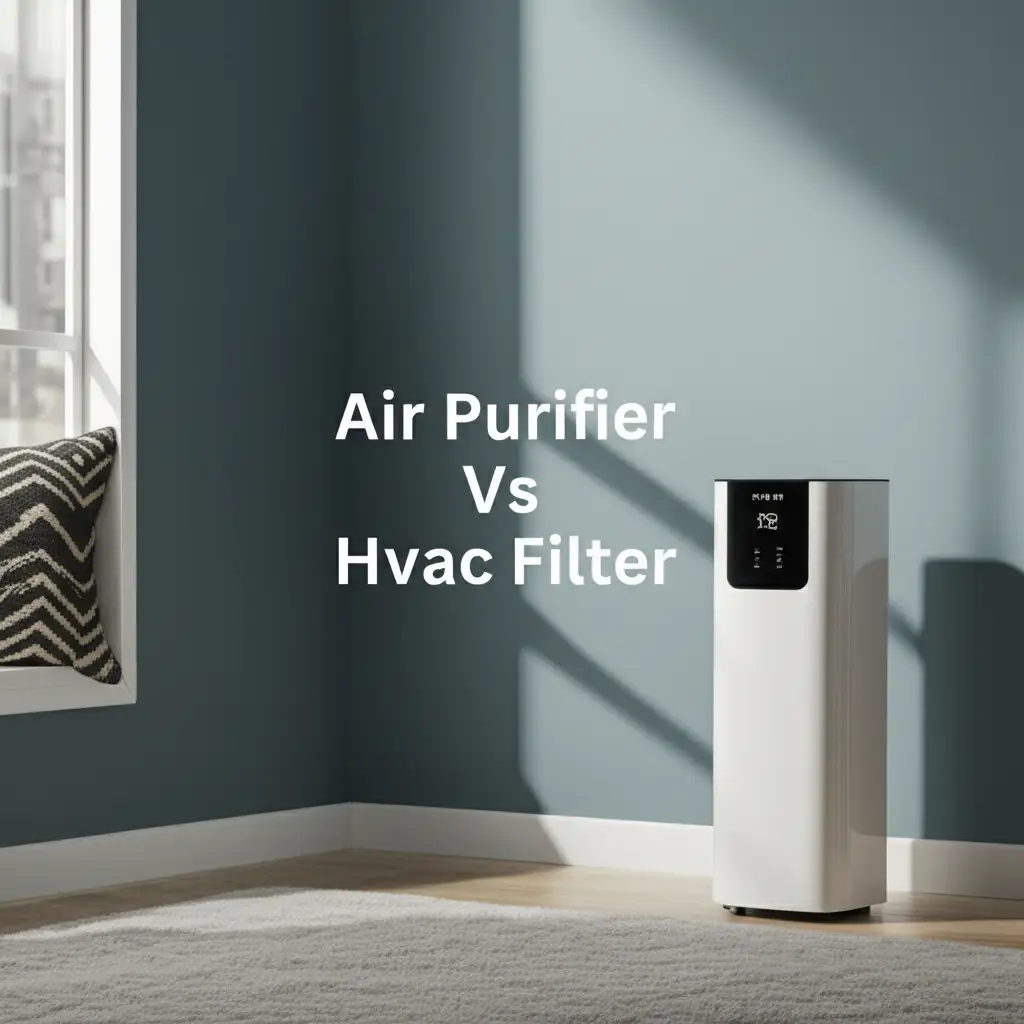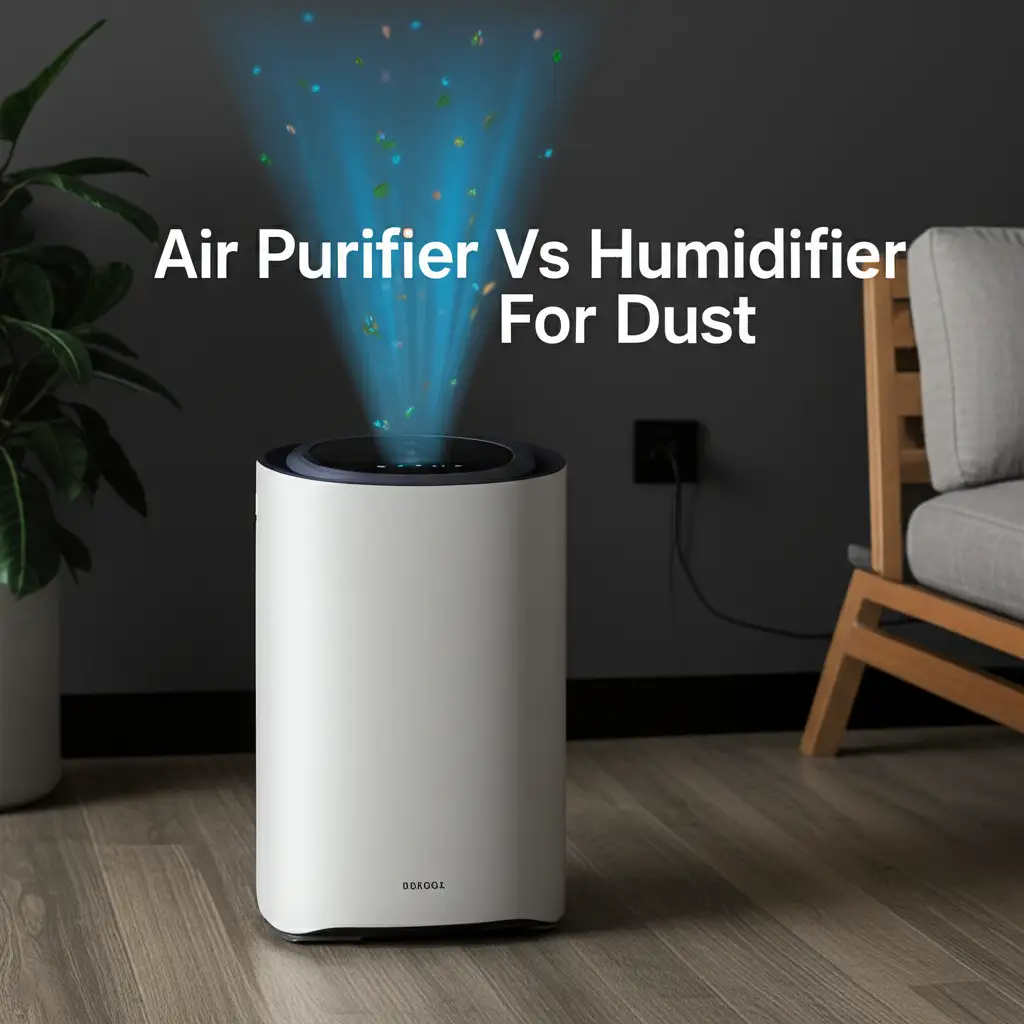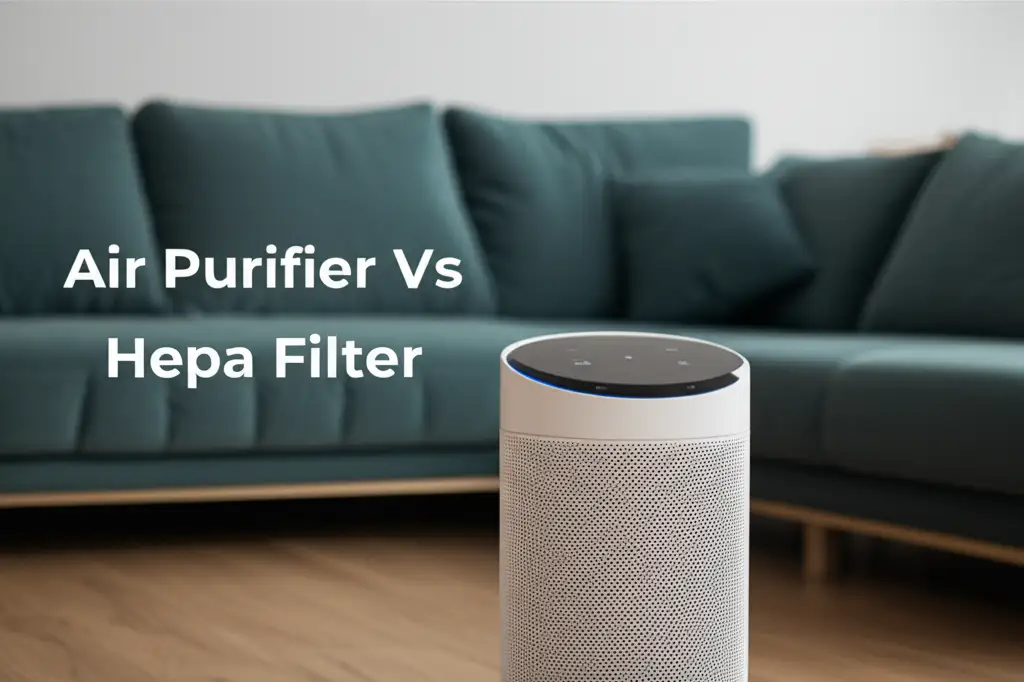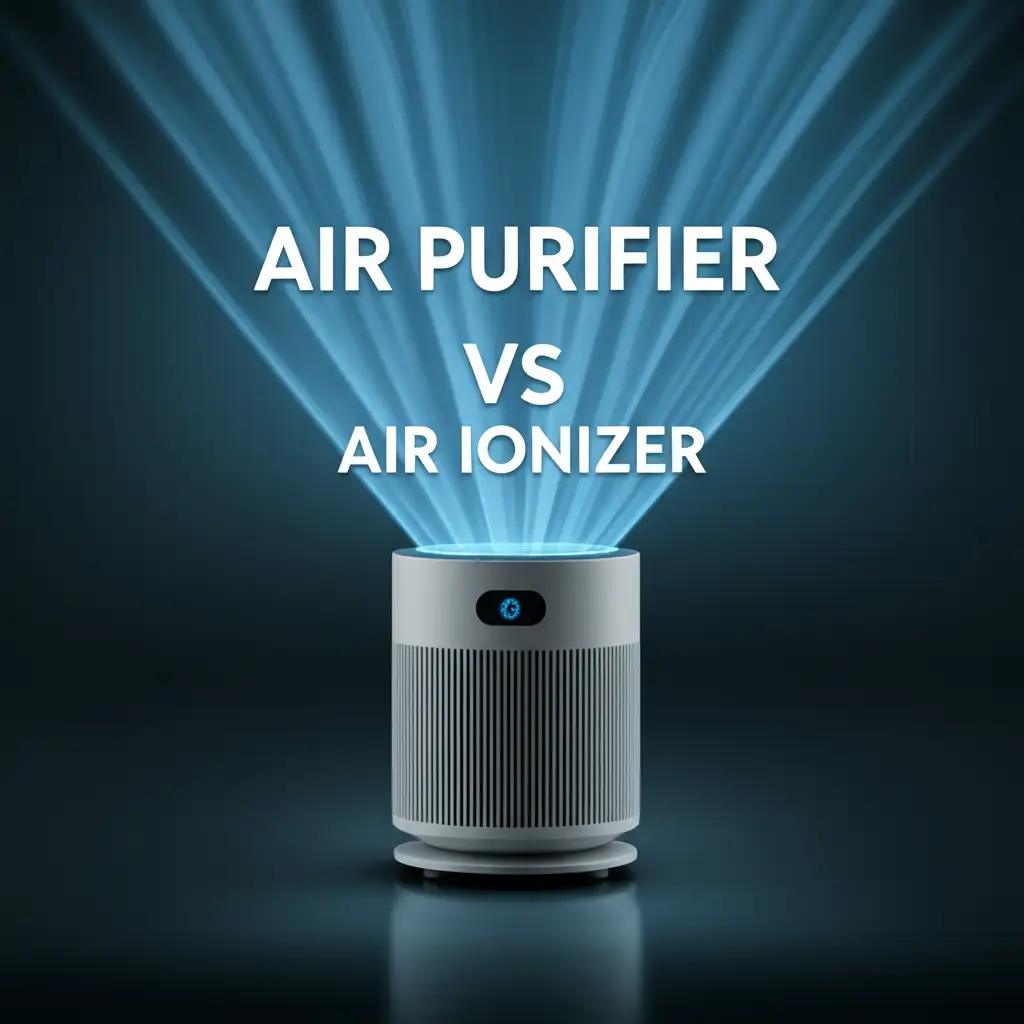· Elira Thomsen · Home Air Quality · 17 min read
Air Sterilizer Vs Air Purifier
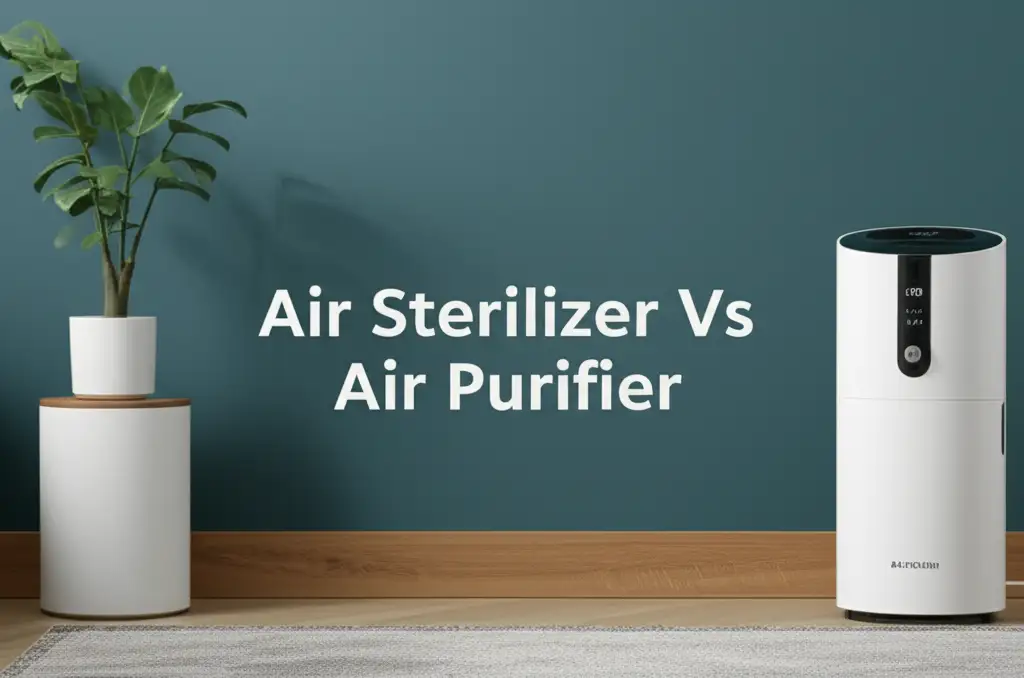
Air Sterilizer vs. Air Purifier: What’s Best for Your Home?
We all want clean air inside our homes. Sometimes, the air we breathe indoors contains many things we cannot see. These include dust, pollen, pet dander, and even tiny germs. Many people consider getting a device to improve their indoor air. They often ask, “Which is better: an air sterilizer vs air purifier?” Both devices aim to make your air better, but they do this in different ways.
Understanding these differences helps you choose correctly. This article explains what each device does. We will look at how they work and what they target. We will also discuss their benefits, costs, and maintenance. My goal is to help you decide which tool fits your needs best for cleaner, healthier air at home.
Takeaway
Choosing between an air sterilizer and an air purifier depends on your specific needs:
- Air Purifiers remove physical particles like dust, allergens, and odors.
- Air Sterilizers kill microorganisms such as bacteria, viruses, and mold spores.
- For general air quality and allergen reduction, an air purifier is often suitable.
- For germ control and sanitization, especially in high-risk areas, an air sterilizer offers specific benefits.
What is the core difference between an air sterilizer and an air purifier?
An air purifier removes airborne particles like dust, pollen, and pet dander from the air using filters. An air sterilizer specifically targets and neutralizes harmful microorganisms such as bacteria, viruses, and mold spores, often using UV-C light or other germicidal technologies.
Understanding the Air Purifier: A Closer Look
An air purifier works to clean the air you breathe. It focuses on removing particles. These particles float in your indoor air. Common examples include dust, pollen, pet dander, and smoke. The main goal of an air purifier is to reduce airborne irritants. This improves general air quality and helps people with allergies.
Most air purifiers use a fan and a series of filters. The fan draws air into the unit. The air then passes through these filters. Each filter traps different types of particles. A common and highly effective filter type is the HEPA filter.
How Does an Air Purifier Function?
Air purifiers use a multi-stage filtration process. First, a pre-filter often captures larger particles like hair and lint. This step protects other filters. Next, the air moves through a HEPA filter. A HEPA filter traps 99.97% of airborne particles as small as 0.3 microns. These particles include mold spores, dust mites, and pet dander.
Some air purifiers also include an activated carbon filter. This filter is excellent at removing odors. It can eliminate smells from cooking, pets, and smoke. Other technologies, like ionizers or UV-C lights, can also be part of an air purifier. Ionizers release charged ions to make particles clump together, making them easier to trap. Some purifiers include UV-C light for added germ-killing action, making them a hybrid device. For a deeper understanding of how these technologies compare, you can read about an air purifier vs air ionizer.
Air purifiers benefit many households. They help people with respiratory issues like asthma. They reduce allergy triggers effectively. If your main concern is allergens or general particulate matter, an air purifier is a strong choice.
Understanding the Air Sterilizer: A Closer Look
An air sterilizer has a different primary goal. It aims to kill or deactivate microorganisms in the air. These microorganisms include bacteria, viruses, and mold spores. Instead of just trapping them, a sterilizer destroys them. This provides a higher level of sanitation for the air. People often use sterilizers in sensitive environments. These include hospitals or medical clinics.
Air sterilizers commonly use specific technologies to achieve this germ-killing effect. The most popular method involves ultraviolet (UV-C) light. Other methods may include specialized filtration or chemical agents. The focus remains on making the air biologically clean.
How Does an Air Sterilizer Function?
The primary method for air sterilization is UV-C light. Air enters the sterilizer unit. It passes through a chamber containing UV-C lamps. The UV-C light breaks down the DNA or RNA of microorganisms. This process stops them from reproducing. It effectively kills or inactivates them. This prevents them from causing illness or spreading.
Some advanced sterilizers combine UV-C with other technologies. These might include photocatalytic oxidation (PCO) or germicidal filtration. PCO uses a UV light with a titanium dioxide catalyst. This creates highly reactive ions. These ions break down volatile organic compounds (VOCs) and destroy microbes. Germicidal filters can be highly dense filters designed to trap even smaller biological agents. Air sterilizers are very important in places where airborne pathogens pose a serious risk. They add a layer of protection beyond simple particle removal.
Air Sterilizer Vs Air Purifier: Core Functional Differences
The most important distinction between an air sterilizer vs air purifier lies in their primary function. An air purifier removes particles. An air sterilizer destroys microorganisms. This fundamental difference guides their design and application. We can break down these differences further.
Filtration Versus Disinfection
Air purifiers rely heavily on physical filtration. They use materials like HEPA filters to physically capture airborne contaminants. Imagine a fine mesh net catching tiny objects. This is how a HEPA filter works. It captures dust, pet dander, and pollen. The particles stay trapped in the filter media. This means the filter needs regular cleaning or replacement. If you want to know more about how these filters work, you can learn about an air purifier vs hepa filter.
Air sterilizers use disinfection methods. They do not necessarily capture particles. Instead, they use technologies like UV-C light to render microorganisms harmless. This process is about breaking down the biological structure of germs. It kills them. The treated air then returns to the room. This process does not remove dust or allergens. It focuses solely on biological threats.
Target Contaminants
Air purifiers target a wide range of common indoor air pollutants. These include:
- Dust and dirt
- Pollen
- Pet dander
- Mold spores (some larger ones may be captured, but not necessarily killed)
- Smoke particles
- VOCs (Volatile Organic Compounds), if equipped with activated carbon filters.
Air sterilizers focus on specific biological agents. Their primary targets are:
- Bacteria
- Viruses
- Fungi (mold and mildew spores)
They do not effectively remove non-living particles. If your home has a lot of dust, a sterilizer alone will not solve that problem.
Airflow and Processing
Air purifiers typically process a large volume of air quickly. They are designed to circulate and filter air throughout a room many times per hour. This rapid air exchange ensures effective particle removal.
Air sterilizers may process air at different rates. The key is ensuring sufficient exposure time to the germicidal technology. The air needs enough time under UV-C light to kill germs. Some units might have slower airflow rates to guarantee this sterilization. The design prioritizes germ exposure over rapid air turnover for particle removal.
Effectiveness Against Common Airborne Threats
Understanding what each device targets helps us assess their effectiveness. Both air purifiers and air sterilizers play roles in improving air quality. However, they excel against different types of airborne threats.
Combating Allergens and Particulates
Air purifiers are highly effective against allergens. Allergens are common triggers for respiratory issues. Dust mites, pollen, and pet dander are examples. A good air purifier with a HEPA filter removes these. It captures them physically from the air. This reduces symptoms for people with allergies or asthma. If your primary concern is sneezing, itchy eyes, or breathing difficulties due to environmental particles, an air purifier is your best ally.
Air purifiers also reduce general particulate matter. This includes fine dust and smoke particles. These small particles can irritate lungs. They contribute to dirty surfaces in your home. By removing them, air purifiers make your living space cleaner. They also create a more comfortable breathing environment.
Neutralizing Bacteria, Viruses, and Mold
Air sterilizers shine when dealing with microorganisms. They specifically eliminate bacteria and viruses. This is crucial during cold and flu seasons. It is also important in homes with vulnerable individuals. Think of infants or elderly people. They benefit from reduced exposure to airborne germs. Sterilizers actively kill these pathogens. They do not just trap them.
Mold spores are another target for sterilizers. While air purifiers can trap some mold spores, sterilizers destroy them. This helps prevent mold growth indoors. It also reduces the spread of existing mold. Mold can cause respiratory problems and allergies. A sterilizer helps reduce these risks. For serious concerns like mold, you might also consider dedicated solutions, as detailed in an article about an air purifier vs dehumidifier for mold. The sterilizer offers a proactive defense against biological contaminants in the air.
Addressing Odors and Chemical Pollutants
Many air purifiers include activated carbon filters. These filters are very good at absorbing odors. They remove smells from cooking, pets, and cigarette smoke. Activated carbon also targets volatile organic compounds (VOCs). VOCs come from paints, cleaning supplies, and furniture. They can cause health issues. So, a purifier with carbon filtration improves air freshness.
Air sterilizers generally do not target odors or chemical pollutants directly. Their UV-C light technology focuses on breaking down microorganisms. They do not absorb gas molecules. If odors or chemical fumes are a problem, a sterilizer alone will not help. For comprehensive air treatment, sometimes a combination of technologies is best. This ensures both germ killing and odor removal.
Health Benefits and Ideal Applications
Both air purifiers and air sterilizers offer significant health benefits. Their ideal uses differ based on the specific air quality challenge. Choosing the right device means understanding your main needs.
Benefits of Air Purifiers for Health
Air purifiers offer widespread benefits for daily indoor living. They dramatically improve air quality for allergy sufferers. By removing pollen, dust, and pet dander, they reduce sneezing and congestion. People with asthma often find significant relief. Less airborne irritants mean fewer asthma attacks. This leads to easier breathing and better sleep.
Purifiers also reduce exposure to common airborne particles. This includes fine dust from outside or from household activities. Reducing these particles supports general lung health. They also minimize the presence of smoke particles. This is beneficial for homes with smokers or near wildfire zones. For a healthy indoor environment, an air purifier is a foundational choice.
Benefits of Air Sterilizers for Health
Air sterilizers provide specific benefits by killing germs. They protect against airborne transmission of diseases. This is very valuable during flu seasons. It helps prevent the spread of colds, flu, and other viral infections. For households with young children or elderly family members, this protection is important. Consider reading about an air purifier vs humidifier for dust to understand how different devices tackle specific issues.
Sterilizers also prevent the spread of mold and bacteria. They destroy spores before they can settle and grow. This helps maintain a healthier environment, especially in humid climates. In healthcare settings, sterilizers are essential. They ensure a clean environment. They reduce the risk of infections. For preventing the spread of illness, a sterilizer provides direct and powerful action.
Ideal Settings for Each Device
Air purifiers are ideal for most residential homes. They suit anyone wanting to improve general indoor air quality. They are perfect for:
- Homes with allergy sufferers
- Pet owners
- Homes in dusty environments
- Urban apartments with outdoor pollution
- Anyone seeking fresher, cleaner air.
Air sterilizers are best suited for environments where germ control is paramount. These include:
- Medical offices, clinics, and hospitals
- Nurseries or daycares
- Homes with immunocompromised individuals
- Areas prone to mold or mildew growth
- During outbreaks of contagious diseases.
For general home use, an air purifier addresses common irritants. For targeted germ killing, a sterilizer is the specific tool. Some devices combine both functions, offering comprehensive air treatment.
Maintenance and Operational Costs
Owning an air quality device involves ongoing costs. Both air purifiers and air sterilizers require maintenance. This ensures their effectiveness. Understanding these costs helps you make an informed decision.
Air Purifier Maintenance Needs
Air purifiers generally require filter replacements. The frequency depends on use and air quality. HEPA filters typically last 6-12 months. Pre-filters might need cleaning or replacement every 2-4 weeks. Activated carbon filters last 3-6 months. Filter costs vary by model and brand. Replacing filters is a critical step. It keeps the purifier working well.
Ignoring filter replacement reduces efficiency. The purifier cannot trap particles well with clogged filters. It might also strain the motor. This could lead to higher electricity use or device failure. Regular cleaning of the outer casing is also advised. This prevents dust buildup. Proper maintenance ensures your air purifier provides clean air consistently.
Air Sterilizer Maintenance Needs
Air sterilizers, especially UV-C models, have different maintenance needs. UV-C lamps have a lifespan. They typically last 8,000 to 10,000 hours. This means replacement every 1-2 years for continuous use. Replacing these lamps is crucial. UV-C light loses its germicidal strength over time. If the lamp is weak, it cannot kill germs effectively.
Some sterilizers may include a pre-filter. This pre-filter protects the UV lamp from dust. It keeps the lamp clean and efficient. These pre-filters might need cleaning or occasional replacement. Sterilizers generally have fewer replaceable parts than purifiers. However, the cost of UV lamps can be higher than standard air filters. Always check the manufacturer’s recommendations for specific models.
Energy Consumption and Long-Term Costs
Both devices use electricity. Energy consumption varies by model, size, and fan speed. Smaller units use less power. Larger units for bigger rooms use more. Always check the CADR (Clean Air Delivery Rate) and wattage. This gives an idea of energy use. Modern devices often have energy-efficient modes.
Long-term costs include initial purchase, replacement parts, and electricity.
- Air Purifier: Initial cost plus recurring filter costs. Electricity use is moderate.
- Air Sterilizer: Initial cost plus recurring UV lamp costs. Electricity use is often moderate, similar to purifiers.
Some hybrid units combine both technologies. These might have higher initial costs. They will also have combined maintenance costs for both filters and UV lamps. Always compare total ownership costs. Think about electricity, filters, and lamps. This gives a clearer financial picture for the lifespan of the device.
Choosing the Right Device for Your Needs
Deciding between an air sterilizer vs air purifier depends on your specific priorities. Both improve air quality, but they tackle different problems. I will help you consider factors to make the best choice for your home.
Assessing Your Indoor Air Quality Concerns
First, identify your primary air quality problem.
- Are you battling allergies or asthma? If you frequently suffer from sneezing, coughing, or breathing difficulties due to dust, pollen, or pet dander, an air purifier is likely your best option. It targets these physical irritants.
- Are you worried about germs and illnesses? If you have young children, elderly family members, or immunocompromised individuals, or if you live in an area with frequent viral outbreaks, an air sterilizer offers germ protection. It kills airborne pathogens.
- Do you have issues with strong odors or chemical smells? An air purifier with an activated carbon filter excels at removing these. Sterilizers do not address odors.
- Is mold a recurring problem? While a dehumidifier is best for mold prevention by controlling humidity, an air sterilizer can kill airborne mold spores. An air purifier helps remove spores.
Understanding your specific challenge helps narrow down your choice.
Considering Room Size and Usage
The size of your room matters. Both devices have a recommended coverage area. This is often measured in CADR for purifiers.
- For air purifiers, match the CADR to your room size. A higher CADR means it cleans more air per hour. For open-plan living areas, you need a powerful unit. For a small bedroom, a compact model works fine.
- For air sterilizers, consider the processing rate and exposure time. Some sterilizers are designed for continuous background operation. Others target specific high-risk moments. Ensure the unit can effectively treat the air volume in your chosen space.
Think about how you will use the device. Will it run continuously? Do you need portability? Some units are designed for specific tasks. For example, a small desktop purifier for your personal space, or a whole-house sterilizer integrated into your HVAC system.
Budget and Long-Term Investment
Your budget plays a role in your decision. Initial purchase price varies widely. More advanced models or larger units cost more. Remember the long-term investment.
- Air purifiers have ongoing filter replacement costs. These costs add up over time.
- Air sterilizers require lamp replacements. These can be less frequent but sometimes cost more per replacement.
Factor in electricity usage. Energy-efficient models save money over time. Sometimes, a hybrid unit costs more upfront. However, it provides benefits of both. This might be a cost-effective solution if you need both particle removal and germ killing. Invest in a reputable brand. They often offer better performance and longer lifespan. Always read reviews before purchasing.
Hybrid Solutions: The Best of Both Worlds?
Some devices combine air purification and sterilization. These hybrid units often feature a HEPA filter for particle removal. They also include a UV-C lamp for germ killing. This offers comprehensive air treatment. They address both allergens and microorganisms.
A hybrid unit can be an excellent choice if you have diverse air quality concerns. It simplifies management. You only need one device. However, hybrid units might cost more. They also have combined maintenance needs. You replace both filters and UV lamps. Assess if your needs truly require both functions. For many homes, a good air purifier is sufficient. For specific health concerns, a hybrid unit might be the ideal investment. It provides ultimate peace of mind.
Frequently Asked Questions
Is an air sterilizer better than an air purifier for allergies?
No, an air purifier is generally better for allergies. Air purifiers use filters like HEPA to capture allergens such as pollen, dust mites, and pet dander. Air sterilizers primarily kill germs like bacteria and viruses. While some sterilizers might trap a few larger particles, their main function is not allergen removal.
Can an air purifier also kill germs?
Some air purifiers include features that can kill germs. Many advanced purifiers incorporate UV-C lights or photocatalytic oxidation (PCO) technology. These components help neutralize bacteria, viruses, and mold spores. Standard HEPA-only purifiers primarily trap particles; they do not kill microorganisms.
How often do I need to replace parts in an air sterilizer?
For UV-C air sterilizers, you typically need to replace the UV-C lamps every 1-2 years. The lifespan of a UV lamp is usually around 8,000 to 10,000 hours of continuous use. Some models may also have a pre-filter that needs occasional cleaning or replacement, similar to air purifiers.
Are air sterilizers safe to use in homes with pets or children?
Yes, air sterilizers are generally safe for home use when operated correctly. UV-C light is contained within the unit, preventing direct exposure. Always ensure you follow the manufacturer’s instructions for installation and maintenance. Choose a reputable brand that adheres to safety standards.
Can an air purifier help with pet odors?
Yes, an air purifier with an activated carbon filter can effectively help with pet odors. Activated carbon is excellent at absorbing gaseous pollutants and smells, including those from pets. Standard HEPA filters alone will trap pet dander but do not remove odors.
What is the average lifespan of an air purifier?
The average lifespan of a well-maintained air purifier is typically 5 to 10 years. This depends on the brand, model quality, and how often you replace the filters. Good maintenance, like regular filter changes and occasional cleaning, can significantly extend the life of your unit.
Conclusion
Making a choice between an air sterilizer vs air purifier comes down to understanding your specific air quality goals. Air purifiers are excellent at removing physical particles. These include common allergens like dust, pollen, and pet dander. They are ideal for most homes. They help reduce allergy symptoms and improve general indoor air comfort.
Air sterilizers, on the other hand, target microscopic life. They destroy bacteria, viruses, and mold spores. This provides a layer of defense against airborne illnesses. They are especially useful in environments where germ control is a top priority. Ultimately, if your concern is particulate matter and allergens, an air purifier is your primary solution. If airborne germs are your main worry, an air sterilizer offers targeted protection.
For comprehensive air treatment, consider a hybrid unit. These devices combine filtration with germicidal technology. They provide the benefits of both worlds. Regardless of your choice, investing in clean air is investing in your health. Take a step today towards breathing easier. Research devices that fit your unique situation and budget. Your home deserves the freshest air possible.
- Air Purification
- Air Sterilization
- Indoor Air Quality
- HEPA Filters
- Germ Control
- Allergy Relief
- Home Appliances


